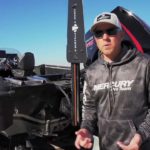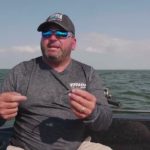Cold Nights and Hot River Walleye Bites
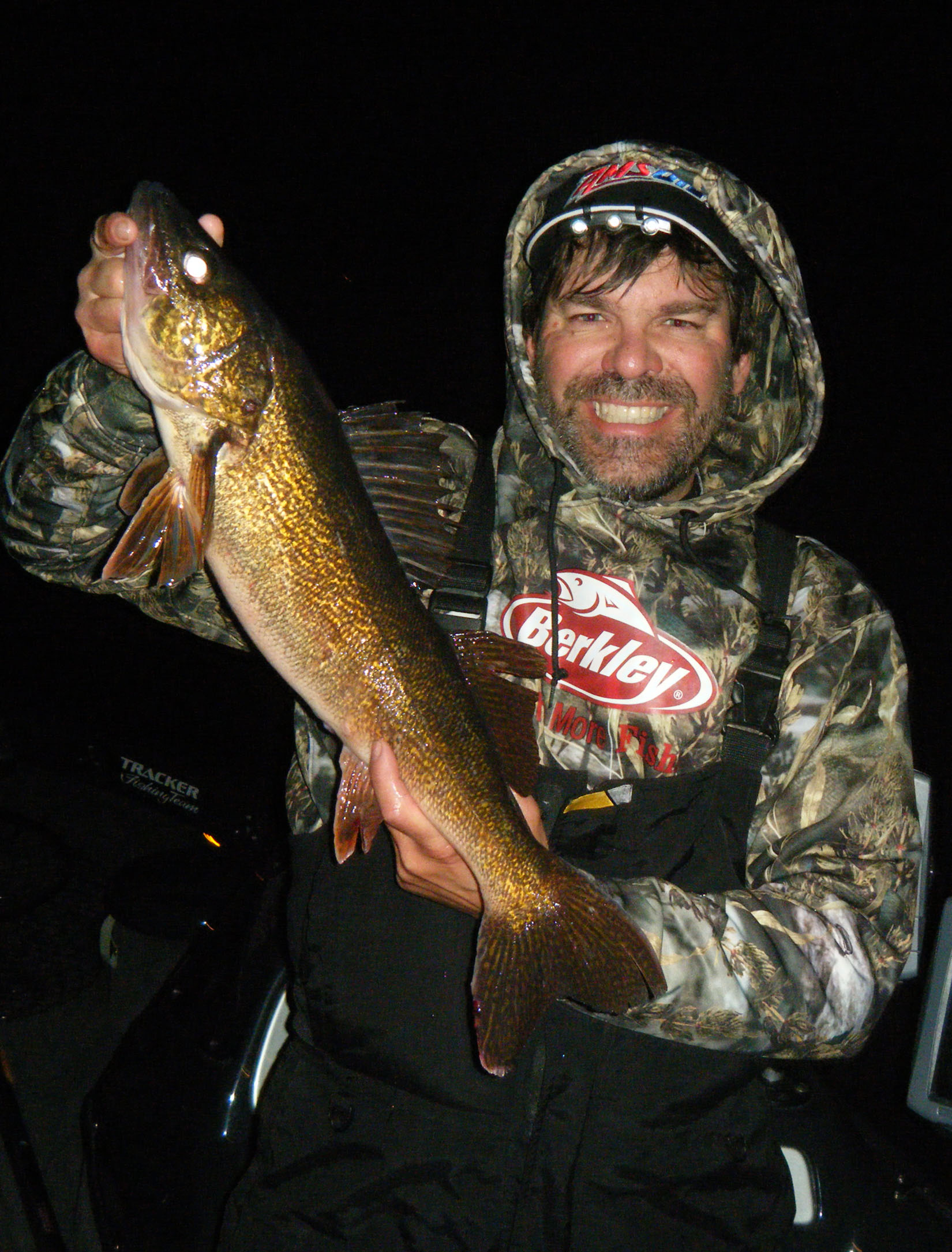 Some of you may have already changed focus from fishing to hunting by now. However, there are a few of us that choose to fish for walleyes right to the bitterly cold onset of winter (when we switch from “soft water” pursuits to ice fishing adventures). If you live near the country’s biggest walleye river, you could be right in the midst of one of the best bites of the year. It’s not a bite for the “fair weather angler”, but it can be one of the most exciting times of the entire year to go for big walleyes.
Some of you may have already changed focus from fishing to hunting by now. However, there are a few of us that choose to fish for walleyes right to the bitterly cold onset of winter (when we switch from “soft water” pursuits to ice fishing adventures). If you live near the country’s biggest walleye river, you could be right in the midst of one of the best bites of the year. It’s not a bite for the “fair weather angler”, but it can be one of the most exciting times of the entire year to go for big walleyes.
One of the most popular locations for this is near the town of Red Wing, Minnesota on Pool #4 of the Mississippi River. Just above the dam at Red Wing is a power plant that discharges warm water and helps to keep the river open for at least three to four miles below the dam all winter. That’s where Keith met up with fellow walleye pro Brett King last year on a cold November evening, to shoot an episode for The Next Bite TV series. They met late in the day because to get in on this bite, they would be fishing at night. Although this Mississippi River is nicknamed “Big Muddy” in many areas, this bite is all about clear water. “While we were in pool 4 for this trip, it’s all about the water getting clean in the late fall and winter that makes the night bite go.” explains Brett, “It happens all up and down the Mississippi. We will see 6 to 8 feet of water clarity in a normal winter.” And it’s not just on the Mississippi, as this is a tactic that can be deadly on many of the country’s big walleye rivers.
As with any fishing situation, locating the majority of the fish is key to success. For this particular bite, the key spots contain 3 important components; rock (riprap), current, and depth. You’re looking for riprap shorelines that have a little current sweeping across them, especially ones that have a feeding shelf off the first break and access to deeper water. By a “feeding shelf” we mean an area where the riprap drops off from shore to say 4 feet or so then flattens out for a few feet before dropping off to the deeper water. These walleyes like to set up on these “shelves” and let the current bring them food. Current in the late fall and through winter is way down on the river compared to the rest of the year, so finding the right spots is not as easy as it may sound. Look for spots on river bends and near the dam for the best chance to find good riprap and current.
There’s been a huge shift the past few of years when it comes to cold-water river walleye fishing. It was once considered that the “jig and minnow” was the only bait to use on rivers like this. Walleyes and Saugers are not necessarily real active in these colder water environments, but they do tend to be concentrated in good numbers in relatively defined areas. The subtle attraction of the jig and live minnow fished right in front of their noses has historically proven to be both effective and efficient for catching fish. These days however, river rats are beginning to set aside their minnow buckets in favor of artificial tails. You might think it’s because they’re tired of frosty fingers from dipping in the bait bucket, or fed up with one too many spilled minnow pails leaving the boat’s floor as slick as a hockey rink. The real reason plastic tails are getting so much attention amongst these winter walleye warriors is because they catch fish!
Truth be known, savvy walleye anglers on the Mississippi have been using artificial tails for walleyes longer than most and there are definitely some tails that have proven themselves over the years. The best baits are normally a little bigger than what’s typically used for walleyes, with an action-type tail. A popular favorite on this pool of the Mississippi is a four inch “ringed-body worm”, and so for this outing one of the baits we armed ourselves with was Berkley’s version, the 4 inch PowerBait Ribworm. This type of tail is ideal for pitching technique used for these night feeding ‘eyes as it sinks slowly, and the tail moves seductively in the current with very little effort. The “ribs” on the worm’s body also help it to displace more water as it moves along, adding to its action and helping fish to locate the bait in the darkness.
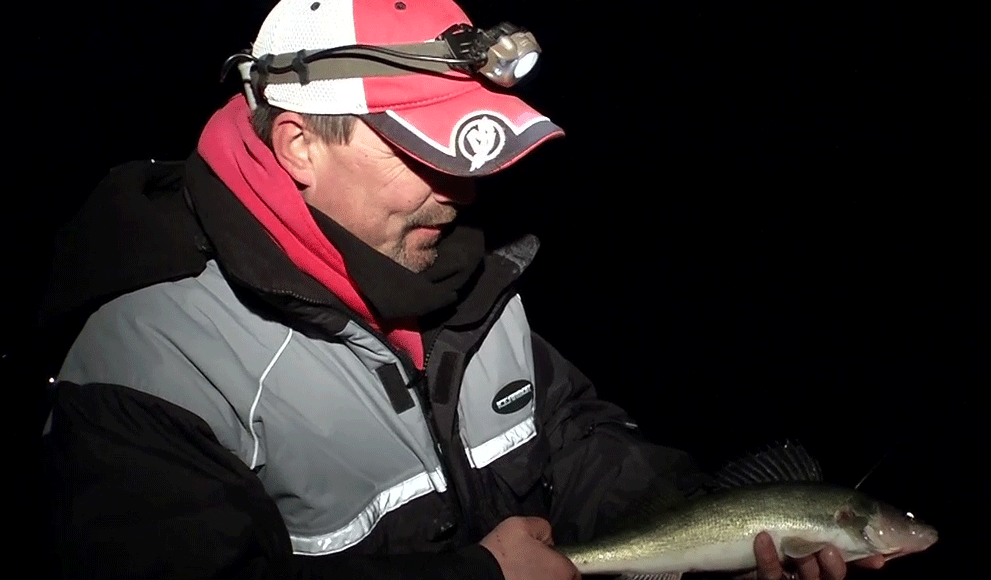 Brett also shared some key secrets to how to fish these baits most effectively; “When you’re pitching jigs like this, how you control and move the jig in the water is crucial to your success.” says Brett, “There’s a real fine line between getting snagged and getting bit. You want the jig to swim just inches off the bottom. If you move it too much, chances are you aren’t going to get a bite.” Brett’s basic tactic is to pitch the jig tight to the shore and watch the line to know when it’s hit bottom. Then he slowly lifts the jig up, letting it sweep back with the current as he reels up the slack line. This cadence continues until the jig is back to the boat. It’s a painfully slow way to fish, but when the fish hit, they REALLY clobber the bait. It’s an awesome bit for sure!
Brett also shared some key secrets to how to fish these baits most effectively; “When you’re pitching jigs like this, how you control and move the jig in the water is crucial to your success.” says Brett, “There’s a real fine line between getting snagged and getting bit. You want the jig to swim just inches off the bottom. If you move it too much, chances are you aren’t going to get a bite.” Brett’s basic tactic is to pitch the jig tight to the shore and watch the line to know when it’s hit bottom. Then he slowly lifts the jig up, letting it sweep back with the current as he reels up the slack line. This cadence continues until the jig is back to the boat. It’s a painfully slow way to fish, but when the fish hit, they REALLY clobber the bait. It’s an awesome bit for sure!
Using the right equipment is also key to success with this technique. While we are strong advocates for using no-stretch lines like Berkley FireLine for jigging, this is one tactic that monofilament line is a better choice. We were using 6 pound test Berkley Trilene Sensation in the Solar and Blaze Orange colors. The bright colored line made it very easy to see the line in with the light from our headlamps and watching your line is critical as it’s the best way to see when the jig is on the bottom. The mono also “flows” in the current much better than a braid line allowing for a much more subtle presentation. Because you’re using a line with more stretch to it, using a very sensitive rod is a must. A six foot high modulus graphite spinning rod like the Bass Pro Shops Walleye Angler Signature Series model WA60MS-HM85 is an ideal choice.
One thing to remember about the jigging action is that it is actually more important to learn to feel the bottom than to learn to feel the bite. The areas that concentrate most of the walleye are typically super snaggy areas. A normal jigging presentation (where you let the jig hit the bottom before reeling down and lifting again) will result in snags and re-tying. Just the little bit of time it takes to reel down may allow the jig to be swept into a rock crevice. So watch the line and as soon as it deflects (indicating it has hit the bottom) – lift the jig 6 inches and let it start flowing again.
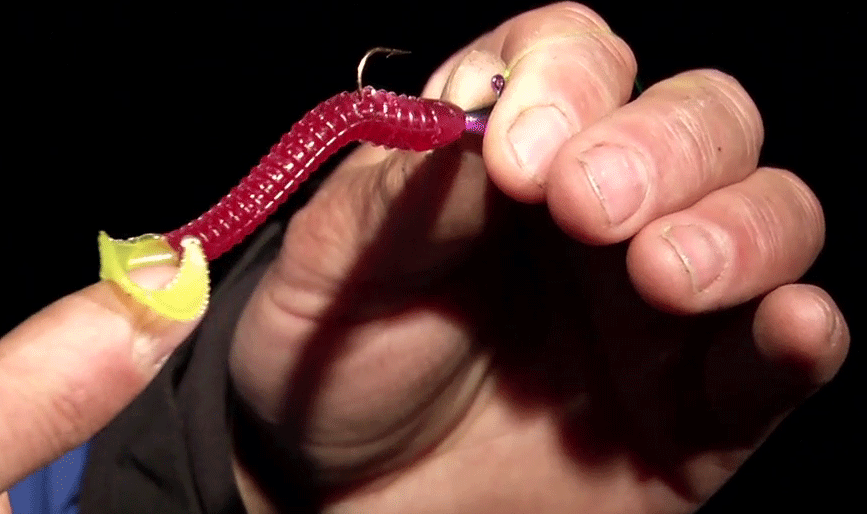 Color of the jig did not seem to matter as much for this type of fishing, but using a light jig is important. 1/8 ounce is the common size, but if there is little or no wind and if the current is fairly subdued, use a 1/16 ounce head. The lighter head will allow the jig/body combo to sweep just above the rocks longer – right in the strike zone. One style of jig to consider is a semi-standup jig like the Bass Pro Shops XPS Walleye Jig. This type of jig has a flattened bottom that will, more often than not, keep the jig from tipping over when it hits bottom thus preventing snags. The additional benefit is that if it lands upright, the hook is in a great position to contact the roof of the walleyes mouth if the fish happens to suck it off the bottom.
Color of the jig did not seem to matter as much for this type of fishing, but using a light jig is important. 1/8 ounce is the common size, but if there is little or no wind and if the current is fairly subdued, use a 1/16 ounce head. The lighter head will allow the jig/body combo to sweep just above the rocks longer – right in the strike zone. One style of jig to consider is a semi-standup jig like the Bass Pro Shops XPS Walleye Jig. This type of jig has a flattened bottom that will, more often than not, keep the jig from tipping over when it hits bottom thus preventing snags. The additional benefit is that if it lands upright, the hook is in a great position to contact the roof of the walleyes mouth if the fish happens to suck it off the bottom.
Boat positioning is critical for this type of presentation too. You need to be close enough to reach within a foot or so of shore with a light jig, but not so close that you are on top of the fish. One piece of equipment we are really looking forward to using with this technique is the “anchor” mode on the new MotorGuide Xi5 trolling motor. With this mode, the trolling motor uses GPS to hold right on the spot that you “anchor” on. Yes there are trolling motors out there that already do that – but the advantage of the Xi5 is that it has a “Jog” function. Jog will reposition the boat in increments of 5 feet simply by pushing button on the hand held key FOB. For example, let’s look at a spot where we want to start downstream of the stretch with the shoreline to our left. In this scenario you would “anchor” at the bottom of the stretch. Make several casts remembering that casting just a little to the side will give you a completely different drift path and might trigger a bit. One this area is covered, then “jog” several feet to the cover the next little stretch. The nice thing is, if you want to jog 20 feet ahead, you simply push the Up button on the key FOB 4 times and it will move ahead 20 feet. Get a little too close to shore – push the right button to move out 5 feet further from shore. Once anchored the motor does all the work holding the boat in a precise position – the anglers can concentrate on fishing.
Night fishing, especially in cold weather, has its own set of challenges. Make sure you are dressed right for the conditions, have a powerful headlight that shoots a spotlight all the way to shore and have plenty of flashlights and spare batteries on hand. The November nights can be cold, but the walleye bite can be hot enough to keep you warm and ready for your Next Bite.




